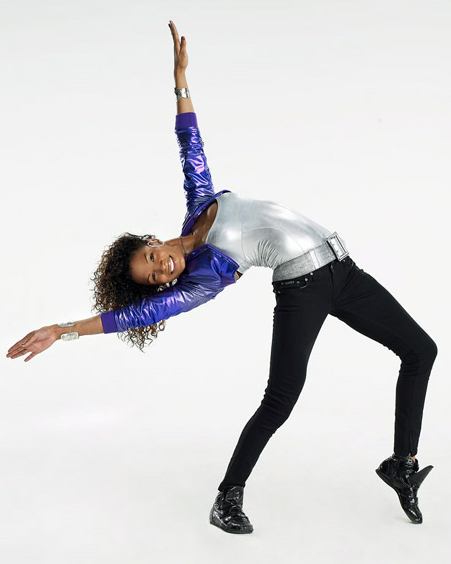
Vogue or voguing is a
highly stylized, modern house dance that evolved out of theHarlem ballroom scene in the 1980s. It gained mainstream exposure
when it was featured in Madonna's song and video "Vogue" (1990), and when showcased in the 1990
documentary Paris is
Burning (which went on to win the Grand Jury
Prize at the 1991 Sundance Film Festival). After
the new millennium, Vogue returned to mainstream attention when the dance group
Vogue Evolution competed on the fourth season of America's
Best Dance Crew.
History

Inspired by Vogue magazine,
voguing is characterized by model-like poses integrated with angular, linear,
and rigid arm, leg, and body movements. This style of dance arose from Harlem ballrooms by African Americans and Latino
Americans in the early
1960s. It was originally called "presentation" and later
"performance". Over the
years, the dance evolved into the more intricate and illusory form that is now
called "vogue". Voguing is continually developed further as an
established dance form that is practiced in the gayballroom scene and clubs in major cities throughout
the United States—mainly New York City.
Formal competitions occur in the form of balls held
by "houses"—family-like collectives of LGBT dancers and performers. Some legendary houses include the
House of Garcon, the House of Icon, the House of Khanh, the House of Evisu, the
House of Karan, the House of Mizrahi, the House of
Xtravaganza, the House of Ebony, the House of Revlon, the House of
Prodigy, the House of Escada, the House of Omni, the House of Aviance, the
House of Legacy, the House of Milan, the House of Infiniti, the House of
Pend'avis, the House of LaBeija, the House of McQueen, the House of Ninja, and
the House of Andromeda among others ("Legendary" in ballroom terms
refers to a house that has been "serving", that is, walking or
competing on the runway, for twenty years or more). The House of Ninja was
founded by Willi Ninja, who is considered the
godfather of voguing. Members of
a house are called "children". Sometimes children legally change
their last name to show their affiliation with the house to which they belong.
Styles

There are
currently three distinct styles of vogue: old
way (pre-1990); new way (post-1990);[7] and vogue
femme (circa 1995). Although vogue "femme" has
been used in the ballroom scene as a catch-all phrase for overtly effeminate
voguing as far back as the 1960s, as a recognizable style of voguing, it only
came into its own around the mid-1990s.
It should be noted that the terms "old
way" and "new way" are generational. Earlier generations called
the style of voguing the generation before them practiced "old way".
Voguers, therefore, reuse these terms to refer to the evolutionary changes of
the dance that are observable almost every ten years. Ten years from now,
today's "new way" will likely be deemed the "old way".
Old way
Old way is characterized by the formation of lines,
symmetry, and precision in the execution of formations with graceful,
fluid-like action. Egyptian hieroglyphs and fashion poses serve as the original
inspirations for old way voguing. In its purest, historical form, old way vogue
is a duel between two rivals. Traditionally, old way rules dictated that one
rival must "pin" the other to win the contest. Pinning involved the
trapping of an opponent so that he or she could not execute any movements while
the adversary was still in motion (usually voguing movements with the arms and
hands called "hand performance" while the opponent was
"pinned" against the floor doing "floor exercises" or
against a wall).
New way
New way is characterized by rigid movements coupled
with "clicks" (limb contortions at the joints) and "arms
control" (hand and wrist illusions, which sometimes includes tutting and locking). New way can also be described as
a modified form of mime in which imaginary geometric shapes,
such as a box, are introduced during motion and moved progressively around the
dancer's body to display the dancer's dexterity and memory. New way involves
incredible flexibility.
Vogue femme
Vogue femme is fluidity at its most extreme with
exaggerated feminine movements
influenced by ballet and modern dance. Styles of vogue femme
performance range from dramatics style (which emphasizes stunts, tricks, and
speed) to soft style (which emphasizes a graceful, beautiful, easy flow). There
are six elements of vogue femme: hand performance, catwalk, duckwalk, floor
performance, dips, and spins (unofficial). When competing in a vogue femme
battle, contestants should showcase all six elements in an entertaining
fashion.
Hand performance refers to the illusions and
movements of the arms, wrists, hands, and fingers. The catwalk is the upright
sashaying in a linear fashion. The duckwalk refers to the crouched, squatted,
foot-kicking and scooting movements requiring balance on the balls of the feet.
Floor performance refers to the movements done on the floor using primarily the
legs, knees, and back. The dip is the fall, drop, or descent backward onto
one's back with one's leg folded underneath. Mainstream dance forms popularized
the dip, which is occasionally called the "death drop" when done in
dramatics style. Due to popular media, the dip is sometimes incorrectly termed
the "5000", "shablam", and "shabam".



No comments:
Post a Comment